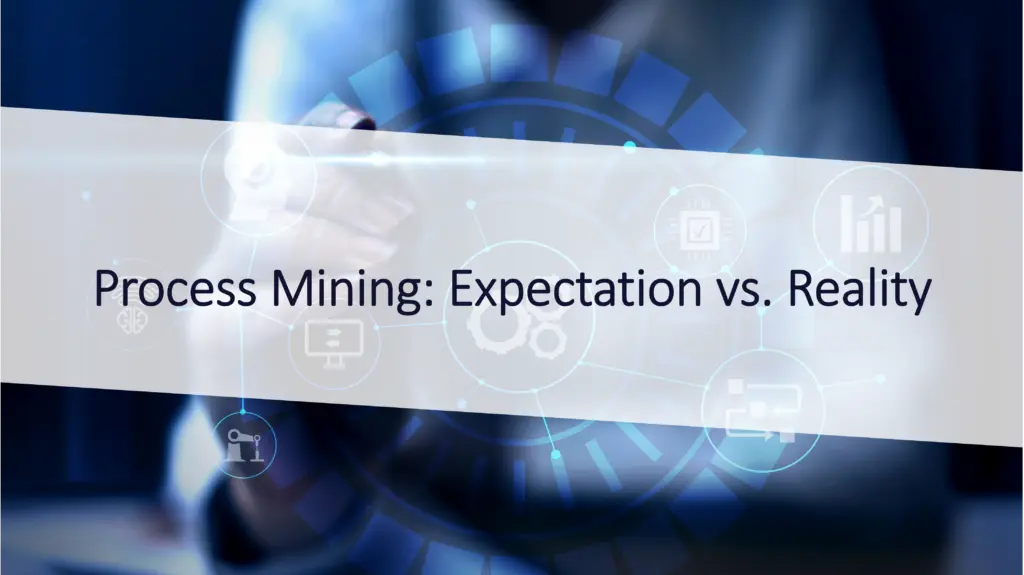Business processes require constant management, improvement, and understanding. Due to the high volume of processes across an organization, and variation within each process based on how users execute them, when it comes time for improvement; without a strategy and framework the initiative become even more dauting. Process Mining provides just that, with data-driven, fact-based insights on how processes actually work.
When companies begin the journey of Process Mining, there can be bumps in the road. Most of them arise due to differences between expectations and reality. In this post, we’ll explain the gaps in expectation versus reality of Process Mining and provide best practices for the technique.
When organizations decide to implement Process Mining, they might have misconceptions about how it works and the expected results.
Common Expectations
When organizations decide to implement Process Mining, they might have preconceived notations about how it works and their expected results. Here are six we most commonly experience:
1. Process Mining is difficult and too complex to implement
2. Process Mining only identifies where to automate
3. Process Mining won’t identify variations
4. Process Mining returns the same value for everyone
5. Process Mining is one and done
6. Process Mining connects to one system at a time
Process Mining is difficult and too complex to implement.
Process Mining platforms use predeveloped algorithms and advanced data transformations to produce these visualizations and insights with far less effort when comparing to traditional BI efforts of the past. However, each organization’s data is slightly different than the ‘out of the box’ formatting of ERP’s or other systems. But Process Mining tools have built in developer tools to allow engineers to remap and format to meet any business need or customized data.
Process Mining only identifies where to automate.
Thinking of Process Mining as the definer of automation is incorrect. Rather, Process Mining is a Continuous Improvement tool, supporting process improvement frameworks and their objectives. When using it in this way, Process Mining illustrates how transactions flow through systems with details on through put, delays, who is performing the activity, and where or why the process isn’t performed the “standard way” every time.
Process Mining delivers transparency, allowing organizations to focus on the process deviations to address them and not spend their time on defining what the process is and does. Solving for deviations can involve automation, and commonly does, but it could also include training resources, reporting, and business process re-engineering.
Process Mining won’t identify variations.
System data builds the process visualizations within the Process Mining tool. Deviations will become visible but only if they exist. If there’s a log of the task, Process Mining will uncover it, regardless of whether it’s an “approved” step or not.
Process Mining returns the same value for everyone.
No company is completely the same. However, every company should be having the same internal conversation when it comes to Process Mining. Do we start small and fast or slow wide and slow? Do we tackle the most complex or quick wins? Do we tackle the highest value opportunity or start with a smaller one? Either way, every business makes decisions to balance the effort and the value to be realized. And every Process Mining efforts success depends on the accessibility of the data, the adaptability of the business unit involved, and the effort required to achieve value.
Process Mining is one and done.
Process Mining is an ongoing exercise because it’s a CPI tool. The first time you do it, you find areas to improve that deviate from the norm through automation, people, and processes. After improving these things and having processes run for a while, you can mine again. Doing so helps you measure the impact of the changes you made and find new areas for improvement.
Process Mining connects to one system at a time.
Process Mining can be applied to any enterprise system within an organization. In the cloud or on-prem, it makes no difference for accessibility. Process Mining allows for the connection between multiple systems to generate comprehensive end-to-end data model, providing insight to the complete process across systems and not only portions of a process relating to a single transactional system.
The Reality of Process Mining
The reality of Process Mining is, implementation is straightforward, process insights are increased across an organization’s business units and significant business opportunities are identified and actionable to realize. Process Mining has become the foundation of Continuous Improvement, intelligent automation (IA) and the source of truth in business operations. According to a 2022 Gartner survey of CFOs found, they consider Process Mining the key driver to delivering returns from technology.
Applying Process Mining before optimizing a process, developing an automation, or implementing a digital migration gives you an end-to-end road map of what and where changes are needed most. With this road map, you can fully understand the impact on a process and the benefits before change.
If you are wanting to explore more about how Process Mining can be a useful tool and framework to understand process failures and work toward improving them; you can read additional ProcessOwl articles, watching XX or downloading XX, or reaching out directly to discuss more.
Interested to learn more? Let’s Chat!

